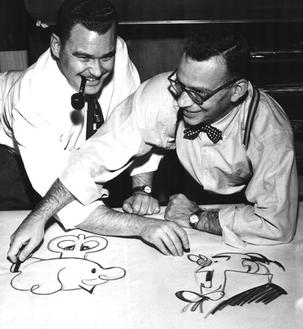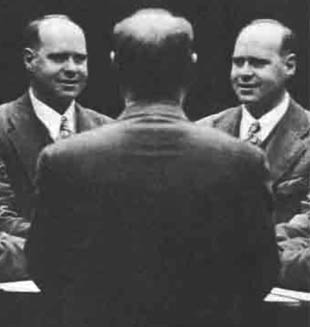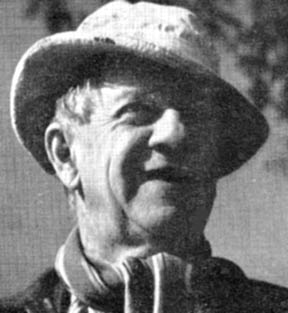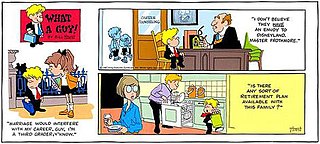A comic strip is a sequence of cartoons, arranged in interrelated panels to display brief humor or form a narrative, often serialized, with text in balloons and captions. Traditionally, throughout the 20th and into the 21st century, these have been published in newspapers and magazines, with daily horizontal strips printed in black-and-white in newspapers, while Sunday papers offered longer sequences in special color comics sections. With the advent of the internet, online comic strips began to appear as webcomics.

A cartoon is a type of visual art that is typically drawn, frequently animated, in an unrealistic or semi-realistic style. The specific meaning has evolved, but the modern usage usually refers to either: an image or series of images intended for satire, caricature, or humor; or a motion picture that relies on a sequence of illustrations for its animation. Someone who creates cartoons in the first sense is called a cartoonist, and in the second sense they are usually called an animator.

The National Cartoonists Society (NCS) is an organization of professional cartoonists in the United States. It presents the National Cartoonists Society Awards. The Society was born in 1946 when groups of cartoonists got together to entertain the troops. They enjoyed each other's company and decided to meet on a regular basis.

They'll Do It Every Time is a single-panel newspaper comic strip, created by Jimmy Hatlo, which had a long run over eight decades, first appearing on February 5, 1929, and continuing until February 3, 2008. The title of the strip became a popular catchphrase.
A gag cartoon is most often a single-panel cartoon, usually including a caption beneath the drawing. A pantomime cartoon carries no caption. In some cases, dialogue may appear in speech balloons, following the common convention of comic strips.
A daily strip is a newspaper comic strip format, appearing on weekdays, Monday through Saturday, as contrasted with a Sunday strip, which typically only appears on Sundays. They typically are smaller, 3-4 grids compared to the full page Sunday strip and are black and white.
Tundra is a comic strip written and drawn by Wasilla, Alaska, cartoonist Chad Carpenter. The comic usually deals with wildlife, nature and outdoor life. Tundra began in December 1991 in the Anchorage Daily News and is currently self-syndicated to over 600 newspapers. The strip was named the best newspaper panel of 2007 by the National Cartoonists Society and nominated again in 2011.

George Lichty was an American cartoonist, creator of the daily and Sunday cartoon series Grin and Bear It. His work was signed Lichty and often ran without mention of his first name.

Laugh Parade was a group of weekly gag cartoons written by Bunny Hoest and drawn by John Reiner. It ran in Parade, a Sunday newspaper magazine supplement.
John Joseph Gallagher (1926–2005) was an American cartoonist and illustrator. He contributed to most major magazines in the 1950s and 1960s, signing his work “Gallagher.” He won the National Cartoonist Society Gag Cartoon Award in 1957 and 1971.
Glenn McCoy is a conservative American cartoonist, whose work includes the comic strip The Duplex and the daily panel he does with his brother Gary entitled The Flying McCoys. McCoy previously produced editorial cartoons until May 2018, when he refocused his career on animations after being discharged from his job of 22 years at the Belleville News-Democrat. All three cartoon features are syndicated by Andrews McMeel Syndication.

Irving David Breger was an American cartoonist who created the syndicated Mister Breger (1945–1970), a gag panel series and Sunday comic strip known earlier as Private Breger and G.I. Joe. The series led to widespread usage of the term "G.I. Joe" during World War II and later. Dave Breger was his signature and the byline on his books. During World War II, his cartoons were signed Sgt. Dave Breger.
Margaret Shulock was an American cartoonist who worked as a writer-artist on several features.

Out Our Way was an American single-panel comic strip series by Canadian-American comic strip artist J. R. Williams. Distributed by Newspaper Enterprise Association, the cartoon series was noted for its depiction of American rural life and the various activities and regular routines of families in small towns. The panel introduced a cast of continuing characters, including the cowboy Curly and ranch bookkeeper Wes. Out Our Way ran from 1922 to 1977, at its peak appearing in more than 700 newspapers.

Clare Victor Dwiggins was an American cartoonist who signed his work Dwig. Dwiggins created a number of comic strips and single-panel cartoons for various American newspapers and newspaper syndicates from 1897 until 1945, including his best-known strip, the long-running School Days.

Life's Like That was a gag panel by Fred Neher which found humor in life's foibles. Spanning five decades -- from October 1, 1934 to August 20, 1977 — the panel was initially distributed by Consolidated News Features, and later by the Bell-McClure Syndicate and the United Feature Syndicate.

Richard Sidney Yager was an American cartoonist most famous for his work on the Buck Rogers comic strip during its heyday in the mid-20th century.
Dana Summers is an American editorial cartoonist and comic strip creator, whose work is syndicated by Tribune Content Agency. His editorial cartoons are published in the Orlando Sentinel, usually reflecting a conservative opinion. He also created the Bound and Gagged comic strip, and co-wrote The Middletons with Ralph Dunagin.

What a Guy! is an American comic strip created by Bill Hoest and Bunny Hoest, the team responsible for The Lockhorns and Agatha Crumm. It began in March 1987, just over a year before Hoest's death in 1988.

The Chicago Daily Times was a daily newspaper in Chicago from 1929 to 1948, and the city's first tabloid newspaper. It is best known as one of two newspapers which merged to form Chicago Sun-Times in 1948. For much of its existence, the paper also operated the small Chicago Times Syndicate, which distributed comic strips and columns.












